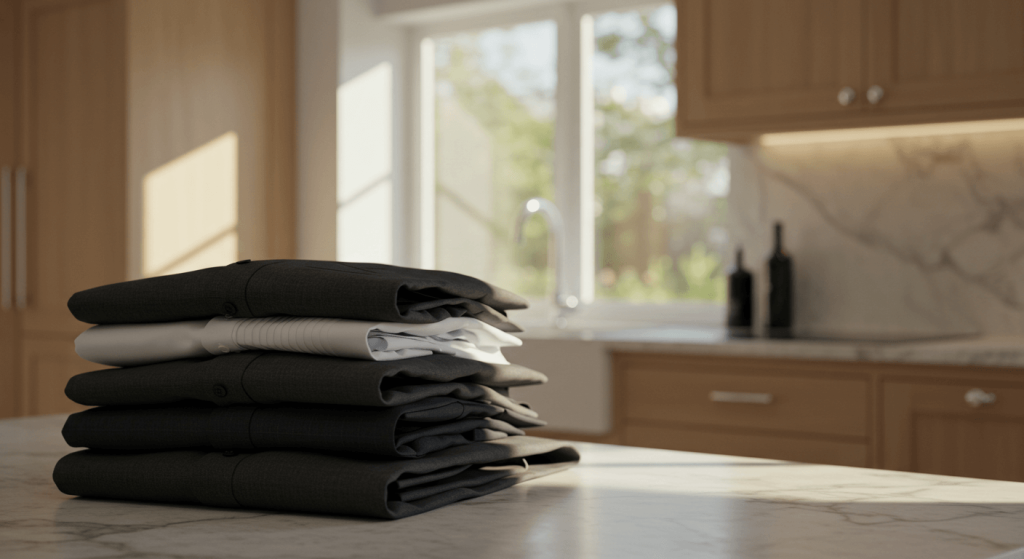How to Avoid Common Ironing Mistakes at Home

A sense of satisfaction hits when you wear a perfectly pressed shirt and crisp trousers. But ironing remains a challenging and tedious task. Multiple common ironing mistakes can occur, such as using the wrong temperature and skipping essential steps. It’s easy to fall into traps that turn a simple task into a frustrating one. Understanding these common ironing mistakes is the first step towards achieving professional-looking results right in your own home.
You can become a pro at ironing even if you don’t know how to iron properly or don’t like it. This blog will explore the most common ironing mistakes people make, providing practical advice and solutions to help you avoid them. Get ready to smooth out those wrinkles and achieve a polished look with our easy ironing tips for every fabric.

Understanding the Basics of Ironing
It is crucial to understand the basics of ironing to achieve those perfect, crisp results. When you know how ironing works, you’re less likely to make common ironing mistakes like using the wrong heat setting or pressing too hard. Following the easy ironing tips for every fabric saves time, protects your garments, and makes the entire process easy:
Choose the Right Ironing Equipment
- Use a high-quality iron with adjustable temperature and steam settings.
- An ironing board with padding helps maintain even pressure and comfort.
- Steam irons are ideal for deep wrinkles and heavier fabrics.
- Lightweight irons are better for quick touch-ups and travel use.
- Invest in a heat-resistant mat or rest stand for safety.
- Or skip the hassle entirely with an ironing service for students in Manama and Riffa.
Set the Correct Temperature for Each Fabric
- Always read the care label before ironing to know the safe heat range.
- High heat can scorch delicate items, such as silk or polyester.
- Low heat may not be adequate on thicker materials, such as cotton or linen.
- Using the wrong setting is one of the most common ironing mistakes.
- Pre-sort clothes by fabric type for a smoother workflow.
- Proper temperature control provides longer fabric life and better results.
Prep Your Space
- Select a well-lit, flat surface to prevent accidents and enhance visibility.
- Keep water spray bottles and fabric-safe starch within reach.
- Clear the area of clutter for a smooth, uninterrupted routine.
- Have hangers ready to place clothes right after ironing.
- Use a chair or stool if ironing a large load to avoid fatigue.
- A clean and safe space enhances both safety and efficiency during the ironing process.
Pre-Ironing Mistakes to Avoid
To achieve optimal results, it is essential to have a thorough understanding of both the pre- and post-ironing processes. We will discuss both processes. Moreover, you must create a pre-ironing checklist to make sure you cover all the steps. Here are some of the common pre-ironing mistakes one must avoid:
Ignoring the Fabric Label
- Don’t skip the label on your fabric, as it tells you everything.
- Ignoring it leads to scorches, shiny patches, or even holes.
- Not all fabrics are adaptable to steam; some can get ruined by it.
- Delicates, such as silk or chiffon, require extra care.
- Labels also guide you on inside-out ironing or no-iron care.
- Read the labels carefully, because they can save your outfit.
Ironing Dirty or Stained Clothes
- Ironing over stains is like setting them permanently like a stone.
- Heat locks in dirt and discoloration, making them harder to remove.
- Even invisible marks (like sweat) can turn yellow under heat.
- Stains can transfer from your iron to other clothes.
- Always check your clothes in good light before ironing.
- Give them a quick wash first, even if they seem clean.
Not Sorting Clothes by Fabric Type
- Ironing your cotton and silk garments back-to-back can be a bad move.
- Each fabric requires a different temperature, and it is essential to know the suitable temperature range for each fabric, as guessing can lead to damage.
- Start with low-heat items, then gradually proceed to high-heat items.
- Sorting saves time adjusting the heat every few minutes.
- It prevents burning or under-ironing delicate and thick fabrics.
- Grouping similar materials makes your ironing flow smoother.
- It’s one of those smart habits that feel pro-level with zero effort.
Post-Ironing Mistakes to Avoid
Even after perfectly ironing your clothes, small post-ironing mistakes can undo all your hard work. Leaving clothes in a pile, not folding or hanging them immediately, or mishandling a hot iron can lead to fresh wrinkles, fabric stretching, or even burn marks.
For such important pieces, it’s often smarter to trust the experts. You can rely on the best ironing service in Manama and Riffa to handle your clothes with care and precision.
Not Hanging or Folding Clothes Immediately
- Leaving clothes in a heap after ironing causes fresh wrinkles to form.
- It’s one of the common ironing mistakes that ruins all your effort.
- Hanging clothes right away helps set the pressed shape properly.
- Folding immediately keeps clothes crisp if you don’t have hanging space.
- Delays in handling can lead to creases, especially in delicate fabrics.
- Use padded or shaped hangers to maintain garment structure.
- Quick action is essential for achieving lasting results in smart after-ironing care tips.
Letting the Iron Cool Improperly
- Placing a hot iron face down can damage the soleplate or the surface it is placed on.
- One of the common ironing mistakes is storing it too soon while it is still hot.
- Always set it upright and allow it to cool completely before packing it away.
- Trapped heat can create steam buildup and lead to internal rusting.
- Avoid wrapping the cord around a warm iron to prevent melting or wear.
- Cooling the iron safely helps maintain its optimal performance and extend its lifespan.
- It’s a key step in proper after-ironing care and ironing safety tips that many overlook.
Pro Tips for Better Ironing Results
To achieve those good and crisp results that make you look classy, you need to know the proper ironing techniques. Here are some of the pro home ironing tips that professionals use for that phenomenal crisp:
Iron Clothes While Slightly Damp
- Iron slightly damp clothes because they respond better to heat, making wrinkles easier to smooth out.
- Start ironing before the fabric dries completely for faster results.
- Mist dry clothes lightly with water if needed; this helps prevent common ironing mistakes, such as overheating.
- Dampness reduces the risk of scorching when ironing delicate fabrics.
- Use lower heat on damp fabrics to protect colors and textures.
- This method shortens ironing time and delivers a polished, crisp finish.
- It’s considered the best way to iron clothes without damaging the fibers.
- Damp ironing prevents repeated strokes, reducing fabric wear and heat damage.
Use Distilled Water in Steam Irons
- Tap water often contains minerals that can clog your iron over time.
- Using distilled water prevents buildup and extends the lifespan of the iron.
- It helps maintain strong, consistent steam output for better wrinkle removal.
- Clean steam minimizes common ironing mistakes, such as water spots or rust stains.
- This method is also beneficial for delicate fabrics, as it prevents the accumulation of impurities.
- Fewer mineral deposits mean better glide and heat control.
- Distilled water is the best way to iron clothes with professional results.
- It also reduces maintenance, allowing your iron to perform efficiently for longer.
Bonus Read: Not sure which method works best? Dive into this quick guide on steam vs ironing to find out what’s right for your wardrobe!
When to Skip the Hassle and Call the Pros
No matter how careful you are, some common ironing mistakes, such as stubborn wrinkles and scorch marks, can occur at any time. If you’re dealing with delicate fabrics, large laundry loads, and don’t have the time, then you must leave it to the experts. Professional services like Love2Laundry are equipped to handle a wide variety of materials safely and efficiently.
They follow home ironing tips that provide precision and garment care without the risk of damage. Instead of stressing over heat settings or water stains, you can rely on trained hands to do it right.
FAQs – How to Avoid Common Ironing Mistakes at Home
What am I doing wrong with ironing?
You may be making common ironing mistakes, such as using the wrong heat setting or not sorting fabrics properly. These ironing mistakes at home can lead to burns, wrinkles, or fabric damage.
What are the important rules for ironing?
Always check garment labels, use the correct temperature, and iron delicate fabrics inside out. Following these home ironing tips helps avoid common ironing mistakes and keeps clothes looking new.
What is the trick to ironing?
The key is to use smooth, straight strokes on slightly damp fabric for best results. This simple technique reduces ironing mistakes at home and enhances your home ironing routine.
Wrap Up!
Avoiding common ironing mistakes isn’t just about skill; it’s about awareness and proper technique. By choosing the right tools, preparing your space, and avoiding the most frequent ironing mistakes at home, you can keep your clothes crisp and damage-free.
Whether it’s reading fabric labels, sorting clothes by material, or using steam correctly, these home ironing tips will elevate your laundry game. And if it still feels like a chore, don’t stress. Schedule your first ironing pickup and let the pros handle it.


